HE-400i
back to HIFIMAN
back to measurements
home
Published: Jul-17-2017, updated Aug-17-2021
NO SMOOTHING is applied to the shown plots. Most measurement sites have some smoothing applied which ‘irons flat’ sharp peaks and ‘wiggles’. I do not use smoothing because some info about sound quality is lost when plots are smoothed.
Aside from a small correction of the microphone itself also some correction in the lowest frequencies is applied to the plots to compensate for the perceived loss of bass when using headphones. This is described HERE in more detail.
A ‘horizontal‘ frequency response curve on the shown frequency response plots on this website thus indicates a perceived ‘flat’ tonal signature.
ALL measurements are made with a good SEAL on a flatbed measurement rig.
The shape of your head, bone structure, pad size, pad ‘softness, (compliance), hair or no hair and or wearing glasses may (drastically) change the frequency response of some headphones, so… your personal experience may differ substantially from these plots.
Frequency response (tonal balance) is the most sound-determining aspect of headphones. A horizontal line shows audible neutral response in the plots on this website. Deviations in different severities at different frequency bands have an effect on the sound character.
The bigger the deviation the stronger the effect.
Below an aid to help determining the sound character of headphones with relation to the frequency response.

HIFIMAN HE 400i
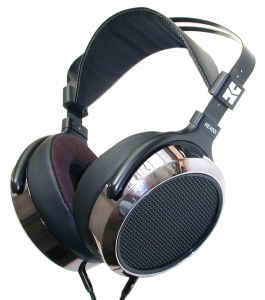
The HIFIMAN HE 400i is an entry level planar magnetic headphone. There is a lot to like about it. This is the newer version with .
The older version (with SMC connectors) is described further down this article.
It retails for around € 500.- which is a bit on the high side.
Comfort is excellent, the clamping force is somewhat on the high side but because of the large pads the pressure is well distributed and ensures a good seal.
The weight of this planar headphone is low compared to ‘similar’ headphone types. This is largely due to the way the drivers are built.
The headphone cable is short and stiff but can be replaced.
The finish is quite nice. High gloss very dark blue-purple-ish. The pads are soft and pleasant to the touch. Pleather (vinyl based fake leather) on the outside, velours on the contact area with the skin and perforated pleather on the inside.
The drivers are angled slightly by the shaped of the pads.
Sound quality at lower volume is excellent.
specifications:
Type: Over ear, open
Usage: Home, portable
Driver type: planar magnetic
Pads: replaceable hybrid (velours+pleather)
Fold-able: No, but can rotate the cups in a flat position.
Headphone connector: 2,5mm TRS (marked L and R)
Cable entry: double sided
Cable: replaceable 1.5m with gold plated 3.5 mm TRS plug and 6.3 mm adapter
Driver size: 60 mm
Nom. power rating: 6 W
Max. S.P.L. 136 dB (15Vrms)
Impedance: 45 Ω
Efficiency: 90 dB @ 1mW
Sensitivity: 103dB @ 1V
Weight: 370 g.
Clamping force: medium/high
Accessories: 6.3mm adapter
Sound description:
The bass is there and nice, ‘tight’ and ‘dry’. Sub-bass is not as pronounced.
The mids are ‘fine’ but not exactly ‘flat’. The mids are forward and present yet not ‘ super clear’. Very hard to explain but will give it a try. Drums, guitars and singers etc are a bit more ‘present’ than on a perfectly flat headphone. Smaller ‘toms’ are a bit too emphasized for instance.
Yet it doesn’t have the ‘edge’ headphones like the HD600 have. In this regard it is more like the HD800 but the HD800 is warmer and has slightly less subbass.
Then there is the treble part. The treble is ‘soft’ in general. good ‘air’ and detail. It doesn’t sound rolled-off nor accentuated nor exaggerated BUT there is a slight ‘rough edge’ to it. A passive in-line filter is available that addresses the 9kHz peak.
This not always obvious but sometimes it just takes something away from the rest of the experience.
measurements:
Below the frequency response of the HE 400i (Left, Right)

The channel balance is very good. Towards 1kHz the FR is tilted slightly upwards which gives the sound a ‘more present/clearer character as opposed to a ‘warmish’ mids as the HD650.
The 10dB dip at 2kHz lowers some sense of the ‘clarity’ and ‘edge/attack’ of certain instruments. It also prevents instruments to become ‘shouty’.
The 8.5kHz peak is very narrow (pointing to a resonance) and peaks about 10dB above the rest.
Because it is very narrow and up high it doesn’t manifest itself as sibilance BUT it sometimes (when overtones are present in that narrow band) it gives the sound an unnatural ‘edge’ that, when removed’ will make the treble perfectly smooth and pleasant.
As this is a newer version with a slightly changed driver as well as the headphone connector below a comparison of the early and later HE 400i (different connectors)
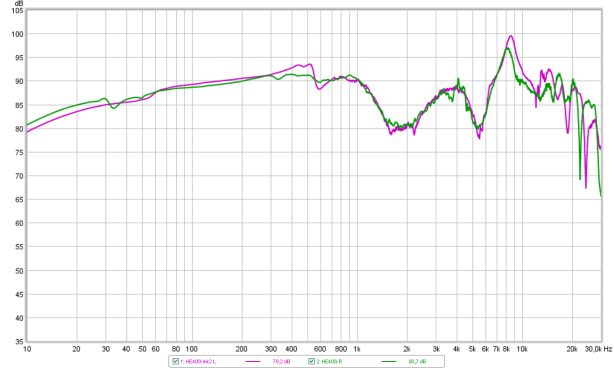
There are small differences visible. Around 550Hz the new version behaves differently and has a resonance there. The treble peak is slightly higher in frequency and about 3dB higher in amplitude. The old version measures slightly better.
The tonal balance differences are shown more clearly in the 1/3 octave smoothed plot below.
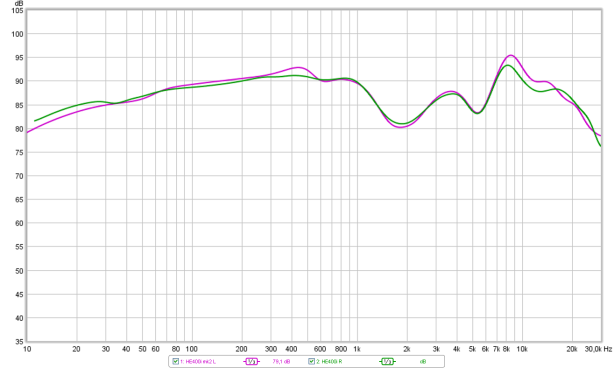
Below the distortion measurements of the HE 400i (Right channel).
Note that this headphone was measured at ![]() where background noises were present in the demo room. As this is an open headphone the distortion levels and spectrum plot performance may thus be better in reality than as shown on the plots due to ambient sounds being measured along with the headphone.
where background noises were present in the demo room. As this is an open headphone the distortion levels and spectrum plot performance may thus be better in reality than as shown on the plots due to ambient sounds being measured along with the headphone.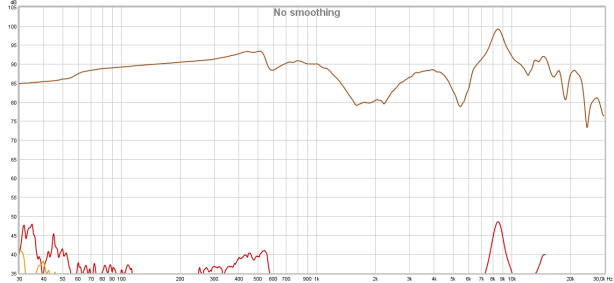
The distortion is pleasantly low and doesn’t go above 0.5%. The distortion peaks in the bass area are (most likely) lower in reality. The peaks are caused by ambient noises during the measurements.
Below the distortion plot but displayed in percentages.
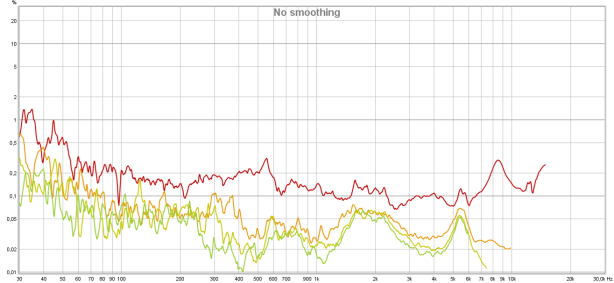
Below the CSD of the HE 400i. (Left and Right are superimposed)
At 6kHz and 12kHz there is some ringing. Especially the higher one is poorly damped but very narrow.
output resistance / damping-factor
As this is a planar magnetic headphone its impedance is as good as ruler flat so a higher output resistance amplifier will have no consequences for the frequency response/tonal balance/damping.
Below the spectrum plot of the HE 400i. At around 550Hz it resonates a bit longer than desirable. 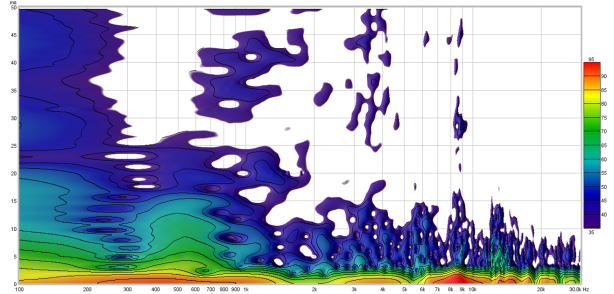
The spurious signals in the upper middle part of the plot are ambient sounds and not from the headphone itself. At 8kHz the peak is visible.
The step response (Right channel) below shows the bass is a bit rolled-off. There is quite some overshoot and some resonances. The ‘stepped signal is actually a 550Hz signal which is very poorly damped. This is also visible in the spectrum plot above.

The left channel shows a similar pattern and thus not shown.
summary
Fit and finish, comfort, weight (for a planar) are nice. The color scheme is certainly different than most other headphones but not everyone may like it.
Stock sound signature is ‘clear’ and open, not splashy nor sibilant.
The 8.5kHz peak gives some recordings a ‘sharp-ish’ edge to them. Some people may be bothered by it, others may not. Something you may have to find out for yourself.
The slight ‘ringing’ at 8.5kHz is something that could be addressed with a very sharp notch EQ. Sub-bass could be a tad more present, can also be adjusted with tone control.
All in all a headphone I can recommend be it that the price is somewhat on the high side (€ 500). Sound quality at lower volume is excellent.
HIFIMAN HE 400i (older version)

The HIFIMAN HE 400i is an entry level planar magnetic headphone. There is a lot to like about it.
Comfort is excellent, the clamping force is somewhat on the high side but because of the large pads the pressure is well distributed and ensures a good seal.
The weight of this planar headphone is low compared to ‘similar’ headphone types.This is largely due to the way the drivers are built.
The headphone cable is a bit short and stiff but can be replaced. I find the SMC connectors a bit less suited for this task but at least they aren’t unobtainium and of good quality.
The finish is quite nice. High gloss very dark blue-purple-ish. The pads are soft and pleasant to the touch. Pleather (vinyl based fake leather) on the outside, velours on the contact area with the skin and perforated pleather on the inside. They angle the drivers ever so slightly. A very nice carrying case comes with it.
Of course it is all about the sound. This headphone doesn’t disappoint there. It is one of those headphones that don’t need modifications and can be used without EQ. That doesn’t need it can’t improve with EQ nor that this is the perfect headphone.
I see this headphone a bit like an HD600 with more subbass. It is a bit brighter but not clearer sounding and the treble is soft but sometimes has an ‘edge’ to it. Not ‘sharp’ sounding just ever so slightly ‘not exactly right’.
The bass and subbass is there. I find the bass nice and ‘tight’ and ‘dry’. Subbass could be a few dB more present though.
The mids are ‘fine’ but not exactly ‘flat’. The mids are forward and present yet not ‘ super clear’. Very hard to explain but will give it a try. Drums, guitars and singers etc are a bit more ‘present’ than on a perfectly flat headphone. Smaller ‘toms’ are a bit too emphasized for instance.
Yet it doesn’t have the ‘edge’ headphones like the HD600 has. In this regard it is more like the HD800 but the HD800 is warmer and has slightly less subbass.
Then there is the treble part. The treble is ‘soft’ in general. good ‘air’ and detail. It doesn’t sound rolled off nor accentuated nor exaggerated BUT there is a slight ‘rough edge’ to it.
This not always obvious but sometimes it just takes something away from the rest of the experience.
Most of it is explained by the Frequency Response graph which is a good thing because this means EQ can address the minor niggles IF you should desire so. Left, Right.
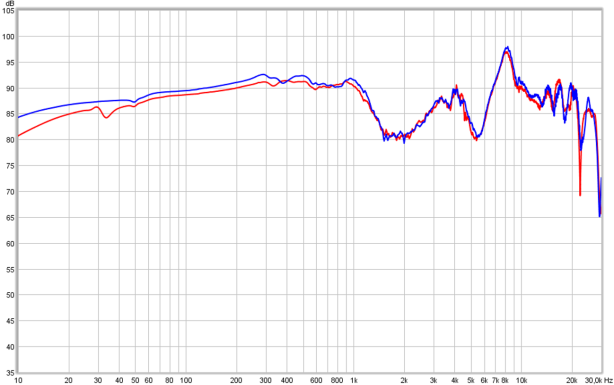
The channel balance is excellent, above 50Hz within 1 dB which is exceptional.
As can be seen the sub-bass is there down to 50Hz but a few dB lower than the mids.
Towards 1kHz the FR is tilted slightly upwards which gives the sound a ‘more present/clearer character as opposed to a ‘warmish’ mids as the HD650.
The 10dB dip at 2kHz lowers some sense of the ‘clarity’ and ‘edge/attack’ of certain instruments. It also prevents instruments to become ‘shouty’. The HD800 also shares this trait somewhat. A dip isn’t nearly as objectionable as a peak so a dip here is no problem and doesn’t need to be compensated by EQ.
The 8kHz peak is very narrow (pointing to a resonance) and peaks 5dB above the rest.
Because it is very narrow and up high it doesn’t manifest itself as sibilance BUT it sometimes (when overtones are present in that narrow band) it gives the sound an unnatural ‘edge’ that, when removed’ will make the treble perfectly smooth and pleasant.
The distortion is comfortably low thus it is no problem to play a bit louder with it and to apply some extra sub-bass/warmth without increasing distortion. Plot of the left channel below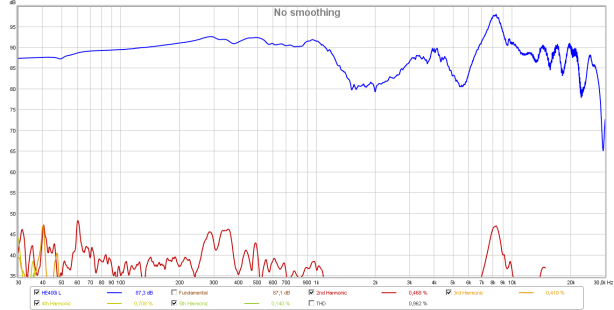
Slightly higher distortion around 300Hz (inaudible to me) and at the 8kHz resonance.
Below the CSD of this headphone, (Left and Right channel superimposed)
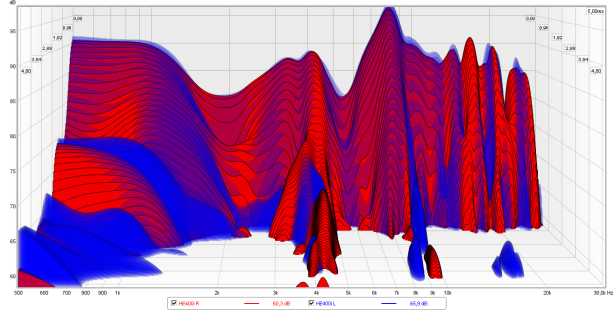
Fast decay below 3kHz. Then the ‘dip’ which has a resonance in the middle (4kHz). Fortunately for our brain the ear canal also ‘rings’ in that frequency band so it isn’t objectionable. The brain ignores the ringing there. The 8kHz peak is double that of the 4kHz. Probably not a coincidence ….. That 8kHz ringing is audible as that ‘unnatural’ sort of edge sometimes. The ringing can not be reduced but the level can which effectively also shortens the ringing slightly. Above 10kHz a very good response.
below the square-wave response plots. The 40Hz is excellent in waveform (nice horizontal red line) which shows the slight upwards tilt in FR as well.
The 440Hz shows the relative ‘lack’ of sharp attack but the horizontal part shows the mids are pretty good.
The 100µs impulse plot shows the ‘sharp’ attack is present (rising edge) and just below the target level. This make the treble ‘fast’ but not exaggerated, smooth. The ringing following the impulse shows the membrane loves to vibrate in a high frequency (8kHz).

The Spectrum plot below also shows the ‘lingering’ 
When this plot is compared to non planar headphones such as the beats Studio Wireless below you can see that the ‘energy’ lingers on longer (up to 20ms) compared to the one below (Beats in this case). Below 1kHz the HE 400i does a lot better than the beats though.

What’s not to like:
The slight ‘ringing’ at 8kHz is something that could be addressed with a very sharp notch EQ.
Sub-bass could be a tad more present, can also be adjusted with tone control.
Cable stiffness and connectors (screw-on)
What’s to like:
Fit and finish, comfort, weight (for a planar). Stock sound signature which is ‘clear’ and open, not splashy nor sibilant.
All in all a headphone I can recommend be it that the price is somewhat on the high side (€ 500-600) and there are alternatives in that price range, though not that much.
Sound quality at lower volume is excellent.
Of course I designed a Kameleon module for it.
It is why the HE 400i was sent in for anyway.
Frequency response on the Kameleon amplifier (with HE 400i module) Left, Right

No more 8kHz peak, increased clarity and ‘air’ and (sub)bass are now on more desirable levels.
Below the difference between the stock HE 400i and via the Kameleon.
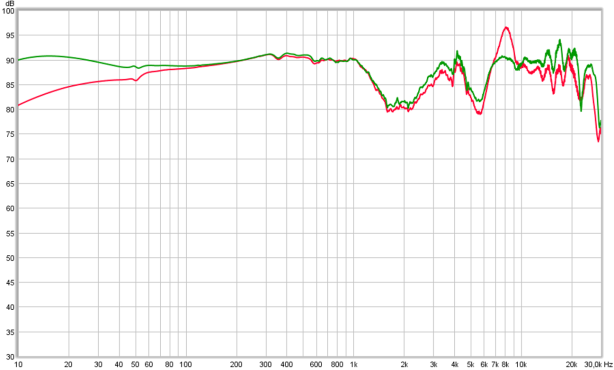
It doesn’t look like a LOT has changed but the +5dB compared to stock at 20Hz is audible.|
More ‘body’ to the sound. Also the removal of the 8kHz peak is audible. Extension to well beyond 25kHz is also improved.
Below the distortion plots of the left channel:

The distortion is quite low, certainly in the lowest frequency range. Exemplary !
Below the CSD (Left and Right channel superimposed) on the Kameleon.

The 4kHz ringing is still there but the 8kHz (which is more offending) is substantially reduced.
Below the square-wave and impulse response plots. On the left the stock HE 400i on the right the same headphone playing via the Kameleon amplifier.
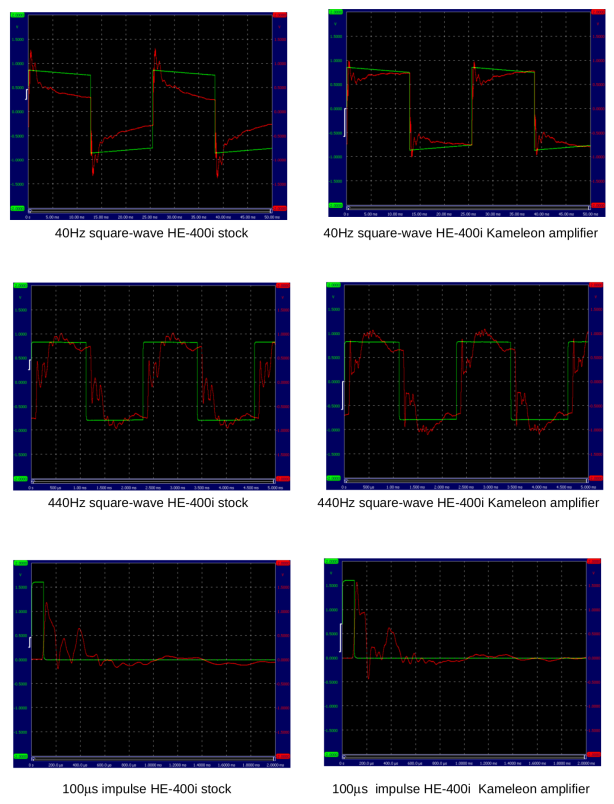
I have rarely seen such nice 40Hz response plots. The 440Hz shows an increase in ‘attack’.
The impulse response shows VERY sharp rise-times, sharper than other headphones I measured. Ringing also is greatly reduced. The FR response also is very well extended.
The sound quality has increased. The ‘edge’ is gone, clarity has improved and the sub-bass is there, deep and tight.
